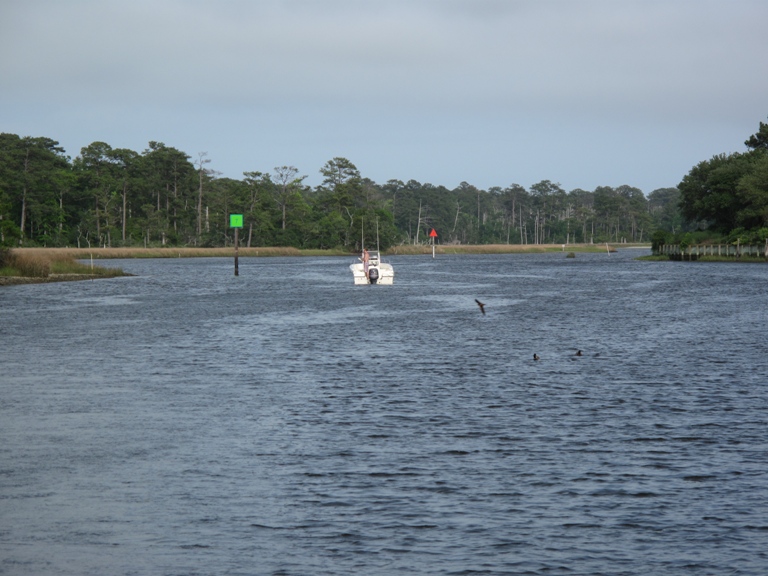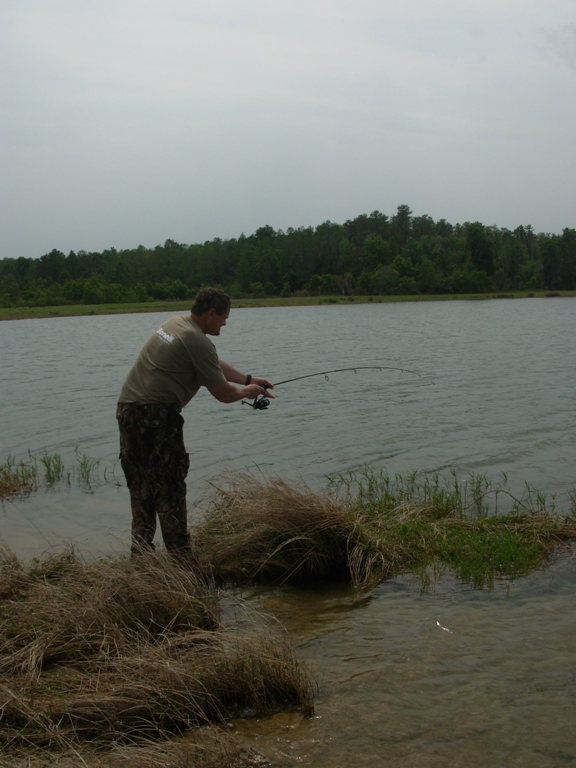NAS Patuxent River Fishing
ATTENTION FISHERMAN
NOTICE: ISPORTSMAN WILL NO LONGER BE ACTIVE FOR FISHING OR HUNTING PERMIT ISSUANCE OR HUNTER CHECK IN/OUT FROM 01 AUG 2017 UNTIL FURTHER NOTICE. Please contact Natural Resource at (301) 342-3670 for further information.
SOLOMON'S RECREATION CENTER: The Solomon's Recreation Center fishing permit requirement has been REINSTATED. Guests wishing to fish on the pier, at NAS or WFA must have an NAS/WFA station fishing permit. All state licenses are also required for all sites.
Holton Pond (Pond 3) is open for fishing. When the pond was drained in 2009 the Natural Resources Branch moved as many fish as possible to other ponds, but some fish did remain in the main channel. Beaver have damed the pond raising the waterlevel and if fisherman would like to fish this pond they may do so.
The installation is working to have the dam replaced and prior to work beginning the waterlevel will again be brought down. Until that time fisherman are welcome to fish this pond. All comsumption limits outlined in the instruction must still be followed and all fisherman must have a state license and station fishing permit.
If you have questions or would like additional information please call:
Natural Resources Office at 301-342-3670.
Fishing Program Information
The NAS Patuxent River fishing program is managed through consultation with state and federal fish and wildlife agencies. Hunters must comply with NASPAXRIVNOTE 11015.7M, as well as appropriate state and federal regulations. These instructions and notices are subject to yearly updates and should be consulted before participating in fishing. They are available under the Regulations section of this site or hard copies are available at the NAS Patuxent River main site, Building 1410.
 The purpose of fisheries management on NAS Patuxent River is to view aquatic habitats in terms of existing resources and usage against a backdrop of key issues and concerns, chief among them is balancing optimal water quality and fish habitat while promoting angling opportunities that create both recreational and scientific management benefits.
The purpose of fisheries management on NAS Patuxent River is to view aquatic habitats in terms of existing resources and usage against a backdrop of key issues and concerns, chief among them is balancing optimal water quality and fish habitat while promoting angling opportunities that create both recreational and scientific management benefits.
Available Fishing Opportunities
Over the past 40 years, a number of species have been stocked in NAS Patuxent River's ponds, including largemouth bass; several species of sunfish, including bluegill, pumpkinseed, redear sunfish and green sunfish; blue and channel catfish; brown and black bullhead; black crappie; and golden shiner. Walleye were stocked in Holton Pond in the 1950s and 1960s, but survived only a few years, as should be expected. The walleye is a fish adapted to the cool waters of deep northern lakes and rivers - not to the warm waters of small impoundments in the coastal plain of Maryland.
Fishable tidal waters of the facility include opportunities primarily for striped bass, bluefish, sea trout, spot, croaker and white perch.
NAS WFA's two small, manmade ponds, Finger and Fishing Ponds, have been maintained and preserved as surface water filtration, groundwater recharge and wildlife/vegetative habitat as well as valuable habitat for finfish. In 1981 and again in 1985, each pond was stocked with largemouth bass and bluegill. Introduction of these species has been very successful; both ponds have been opened since 1990 for fishing.
At SRC, visitors may rent boats to get to the Patuxent River to fish, or may fish from the recreational pier. There are no freshwater fishing opportunitites at SRC.
Although there are areas on board the NAS complex that offer the opportunity to harvest shellfish, due to water quality conditions, the Maryland Department of the Environment has declared the waters either closed or conditional. Therefore, all shellfishing at the NAS complex has been temporarily closed until water quality conditions improve.
Who Can Fish
Fishing is open to active duty military personnel and their dependents, retired military personnel and their dependents, Federal civilian employees assigned to the NAS complex and their dependents, long-term contractors and their dependents, and reservists. Authorized personnel may also sponsor guests. In addition, persons with a valid SRC Leisure Pass may fish at SRC.
Permit Information
Fishing is regulated by a fee/permit system administered by the Conservation Division. Station fishing permits and Maryland state fishing licenses are required of all persons who fish on the station. Fees for fishing permits are announced in NASPAXRIVNOTE 11015.7M. Approximately 2,700 fishing permits are issued annually.
Fishing Permit Costs
- Fishing NAS / WFA - $10
- NAS/WFA Guest One-Day Fishing Permit - $5
- Permit is good for one consecutive 24-hour period. User can purchase multiple one-day permits, though no more than 15 day permits can be purchased in a season.
- NAS/WFA Guest One-Week Fishing Permit - $15
- Permit is good for seven consecutive days. User can purchase multiple one-week permits. No more than five week permits can be purchased in a season.
- Solomon's Recreation Center (SRC) Fishing Permit - $5
- SRC Guest One-Day Fishing Permit - $3
- Permit is good for one consecutive 24-hour period. User can purchase multiple one-day permits, though no more than 15 day permits can be purchased in a season.
- SRC Guest One-Week Fishing Permit - $9
- Permit is good for seven consecutive days. User can purchase multiple one-week permits. No more than five week permits can be purchased in a season.
- NAS/WFA Shellfishing - $20
- PLEASE NOTE: Currently the state has closed this activity. Even when open, no shellfishing is allowed at SRC.
Enforcement of Regulations
Enforcement of hunting and fishing laws and regulations is carried out primarily by the Public Safety Department's Law Enforcement Division. Hunting and fishing violations can be reported anytime by calling the Law Enforcement Division at 301-342-3218.
History of the Fishery
Much of the original fresh, brackish and estuarine areas at NAS Patuxent River have been filled in, dredged out or generally reduced in size over the years, their drainage patterns and access to the main bodies of water (the Patuxent River and the Chesapeake Bay) completely changing from historic origins in the process. These modifications occurred in an original atmosphere that addressed airfield construction and special concerns (such as mosquito control) rather than fisheries management or ecosystem approaches. Fortunately, that approach later changed.
Six small freshwater ponds were constructed at NAS from 1950 to 1975. The first five were developed to provide catch basins for surface runoff and recreational use; the sixth was built to serve as the supply point for the golf course's irrigation system. USFWS biologists began providing fisheries management assistance to NAS Patuxent River in 1955. In 1964, NAS Patuxent River, the Maryland Department of Natural Resources (MDNR) and the U.S. Fish and Wildlife Service (USFWS) entered into an agreement known as the Cooperative Plan for Fish and Wildlife Management.
This agreement has been revised (e.g., to ensure compliance with the 1973 Endangered Species Act), but remains in effect today with the same underlying principle. In terms of fisheries, this involves USFWS's furnishing advice/recommendations for improvement of sportfishing on NAS Patuxent River waters, conducting surveys and stocking gamefish as appropriate; MDNR's supplying technical assistance as necessary; and NAS Patuxent River Conservation Branch providing labor, equipment and materials for habitat improvement and protection.
The stocking effort has been largely successful, having overcome a number of obstacles, such as loss of fish as a result of oil and pesticide contamination. In addition to stocking, removal of dead fish, placement and removal of boards in water-level control structures and shoreline/ aquatic vegetation control have been performed as warranted. A considerable anti-mosquito effort (using DDT) was undertaken in the late 1950s and early 1960s, and blasting was performed (using dynamite) to enhance drainage in 1967. Testing done in 1989 and 1990 found low levels of polychlorinated biphenyls (PCBs), as well as DDD and DDE (by-products from the breakdown of DDT), in fish and sediments from Holton Pond. Further testing was performed in 1995 on fish from Holton Pond, as well as sediment and water from the other five ponds. Traces of DDD and DDE were found in both the fish and the Calvert Pond sediment, and low-level DDT was found in one sediment sample from Sacawaxhit Pond. In all instances, however, the Agency for Toxic Substances and Disease Registry determined that fish in all ponds were safe to eat if consumption was limited. These recommended consumption limits are included in the station's fishing instruction NASPAXRIVINST 11015.7M.
Oyster population surveys have been conducted intermittently at NAS since at least 1959. In addition, cooperative agreements with MDNR foster meetings to monitor the status of the NAS complex shellfish population. As an outgrowth of these meetings, the facility began an Oyster Enhancement Program - by 1966 oyster shells were being placed in Harper's and Pearson Creeks to serve as cultch, or spawning beds, for other oysters. Three thousand bushels of shells were placed north of the bridge over Harper's and Pearson Creeks in 1987. Also, SAV surveys of the three tidal creeks on NAS Patuxent River and tidal inlets at WFA have been conducted intermittently since 1977 as an indirect measure of water quality.
In the mid-1980s, a three-phased artificial fish reef was installed in the Bay waters near the Officers' Club. Created from fiberglass-reinforced plastic reef units, quarry rock piles and concrete reef units, this reef spans roughly 1,500 yards. It was one of the first in a series of reefs constructed as part of the Maryland Recreational Fisheries Program to improve recreational fishing in state tidal waters.
